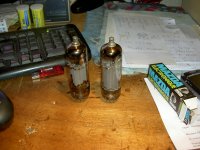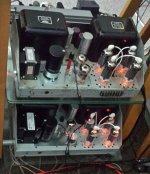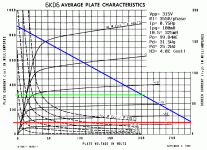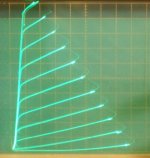4, probably a right angled triangle
It is.
I got 100 "13GB5's" from ESRC in trade for some tubes that Stan wanted. This was back when the 13GB5 was $1 each. All of the tubes were rebranded.
There were 15 or so that were silkscreened in white paint "13GB5 / XL500 KOREA ProComm" I separated them from the rest, and based on one sample assumed that they were junk.
A5(revision number) = XL500/13GB5.........
The other tubes were rebranded by various US brands, most are GE, RCA, Sylvania, Zenith and Admiral. I was under the impression that these were all Mullard tubes, since some actually have the Mullard brand. The Mullards and the Zenith branded tubes say "Made in Great Britain" and have B9J3 or B1J4 codes. Blackburn?
The rest do state "made in Holland" and all are labeled 13GB5 / XL500, but seem to be a mix of XL500 and XL504 according to the codes.
I have started opening boxes and sorting tubes. I plan to test several of these to see if there is any difference between the 500 and the 504.
Sylvania / Phillips ECG definitely engaged in quite a bit of "glass stuffing" near the end of the vacuum tube era. As production wound down and production lines were shut down, it became common to stick the biggest set of guts inside the envelope of several similar tube. There were even some more extreme cases to satisfy government contracts. There were even some 6B4GA's (a DHT) with 6AV5GA line output pentode guts in them. These European tubes may ALL be XL504's except for the mislabeled 27GB5.
The only difference between the 500 and the 504 *should* be the ratings...
Like the 509 and 519 are the same except for the 40W vs 45W max dissipation rating.
You plan on establishing the power needed to melt them?
Like the 509 and 519 are the same except for the 40W vs 45W max dissipation rating.
You plan on establishing the power needed to melt them?

You plan on establishing the power needed to melt them?
I plan to test a few under operating conditions in excess of the ratings, but not for long enough to seriously damage them or shorten their life. These tubes seem to work well at 100 watts audio output for short term. They are too nice to fry without reason. I have plenty of junk, mismatched, one of a kind, or just plain ugly tubes to blow up.
The first Korean tube I tested in Florida red plated badly on one side around 12 or 14 watts, so it met the hammer. There were no obvious defects inside. Smoking amp had one die during testing, which was inspected, and showed a possible bad connection or spot weld.
Based on that I planned on melting a pair, but to my surprise they ran at 100 watts audio power out for 15 minutes continuously. A slight red plate was again seen on one side of each tube, but the dissipation was over 30 watts per tube. 500 volts, 330 mA total plate input (165 watts). Audio power out 102 watts. 63 watts burned in two tubes. The tube on the left was noticeably hotter that the tube on the right. This can be verified by the unequal cathode currents, but I will assume 30 and 33 watts.
Based on the history of the first two Korean tubes, I would not feel comfortable pushing these tubes beyond 50 watts output in an amp unless ALL 16 remaining tubes behave like the last two.
I want to find out if the 500's and the 504's show plate color at the same dissipation level, and what this level is. Both look identical from the outside, and I haven't found any broken or dead ones yet to take apart.
The European tubes have a much bigger plate structure, weigh about twice as much as the Korean tubes, so they should eat more power. If several of each variety show color at the same dissipation level, then I will consider them all the same. If not, then the stronger tubes get saved for the bigger amps.
fierce amp
Got those Verdin Macs going with 6LU8 front end; LTP using the triode sections direct coupled to the pentode sections. 😎 No need for tapped secondary; just wire 4 or 8 ohms to the output jacks and rock on. Over 200 watts per channel; power BW extends from below 20Hz to over 100kHz.:😀D
Got those Verdin Macs going with 6LU8 front end; LTP using the triode sections direct coupled to the pentode sections. 😎 No need for tapped secondary; just wire 4 or 8 ohms to the output jacks and rock on. Over 200 watts per channel; power BW extends from below 20Hz to over 100kHz.:😀D
Attachments
The OPTs are quadrafilar; so the 6KD6's have a screen grid winding. Bass on the Bozak Grands is effortless; the overhead fixtures in the studio do rattle. Good thing the studio is isolated; do not try this at home.
serious headbang machine,
Better think that it is easier to design such a machine than one with 4-8 times less power. Yes, output transformers are bulky, so it requires lot of feedback that causes nasty clipping. But when it delivers plenty of power you won't hear it's clipping. 🙂
Actually not that much overall feedback due to the unity coupled opts. However the local feedback is up there resulting in a very high damping factor.
I have been building television tube audio amps well over 2 decades. In the 90s I went through the rca tube manual looking for the sweep tube with the most heater power. 42kn6 edged out the 40kd6. At the time I did not know that the single plate 42kn6 was a relabled 40kd6. In any case the amps that I built with them simply blew away conventional audio tubes and at a fraction of the price. A 250 watt stereo amp with less than 10 bux worth of glass
speaking of 40KD6 . what is the ideal operating conditions for a PP pentode amp also ideal OPT impedance...Thanks
I usually run them 'Enhanced Triode' using something like a 6KV8 front end; with the FG pentode to drive the screen grids and the control grids connected to the cathodes via a 5K resistor. The triode sections may be wired as a floating paraphase. I usually ran around 1.6K P-P; but anything will work; the huge cathodes can put out well over an amp...
Someone been testing their new tube amp in Forest Grove lately? Must have the N Fdbk reversed.
Mysterious high-pitched tone keeps Oregon residents up at night | NewsDaily
Mysterious high-pitched tone keeps Oregon residents up at night | NewsDaily
speaking of 40KD6 . what is the ideal operating conditions for a PP pentode amp also ideal OPT impedance...Thanks
Don't know about "ideal", but this is what I came up with:
VPP= 315VDC
V22= 110VDC
RL= 355R/phase (1.45K (P-2-P) -- design nominal)
Po= ~100W
h3= 4.0% (est)
You don't need outrageous voltages to get the bigwatts. You will most likely be needing a SS power supply with some stiff filter capacitors, but that's not a problem these days.
The OPT will likely need to be a custom job, and you'll need some gNFB to take the edge off. You could get some sonic improvement with hotter biasing, and/or more output by pushing the specs a bit.
Attachments
Or try these curves (26LX6 = xxKD6)
50 mA/div Vert., 50V/div Horiz., 5.4 V steps on g2 (down from +55V) with a 2.7K Ohm resistor from g2 down to g1. (Crazy Drive) Selecting an "optimal" Zprimary is probably pointless, except for output Z. 55V drive signal versus a 25V drive for g1 drive, but near perfectly linear now.
Edcor makes a 1.7K primary 100 Watt OT., and 2.2K, 2.5K and 3.3K, but anything up to 3.3K would likely be fine, just a matter of how much B+ is needed to get the 100 Watts. Higher Zprimary will give a higher output speaker damping factor (before any Fdbk).
50 mA/div Vert., 50V/div Horiz., 5.4 V steps on g2 (down from +55V) with a 2.7K Ohm resistor from g2 down to g1. (Crazy Drive) Selecting an "optimal" Zprimary is probably pointless, except for output Z. 55V drive signal versus a 25V drive for g1 drive, but near perfectly linear now.
Edcor makes a 1.7K primary 100 Watt OT., and 2.2K, 2.5K and 3.3K, but anything up to 3.3K would likely be fine, just a matter of how much B+ is needed to get the 100 Watts. Higher Zprimary will give a higher output speaker damping factor (before any Fdbk).
Attachments
Last edited:
Thanks guy for your valuable inputs...i'm really planning to build a high power tube amp and its good news to know that KD6 is capable up to 100w of PP power with a lower B+ than my planned GK-71 PP which will have B+ of around 1KV which is a high enough to kill.
I have lots of russian 6P44s, 6P13S Tv tubes also as candidates in PPP output.
I have lots of russian 6P44s, 6P13S Tv tubes also as candidates in PPP output.
I also had an RCA 12W6 laying on the shelf here, which is an up-rated version of the 12L6, so I did some curves for it too.
Looks like the 12W6 could have used about 124V on g2 (instead of 110V) to equal the earlier 12L6 maximums for the g1 and g2 curves. And about 55V for the g2g1 Crazy Drive (instead of 53V).
Found my 12W6's pretty happy in a guitar amp anywhere from the 120-140 range, just to confirm what you're saying.
Thank you Don, very interesting. It confirmed my finding that 12L6 tubes are super as triodes.
I was confronted with these two lately as pentodes in my guitar build and was surprised at the performance of the 12W6 over the 12L6 despite the former appearing as just a higher rated version of the later. Tried some sylvania and GE both in the 'L6 and they sounded the same. Really needed to get the screen voltage up there right under P,diss to get em to sound good. Even so they broke up pretty early in comparison with the 'W6 that I'm having issues being TOO CLEAN 😛.
I found your comment quite funny though, as I've been saving the 'W6 tubes for triodes in a future build as I hear they're very similar in sound and performance to a DHT-45. Maybe the person that told me this had the two mixed around? Either way I'm liking the 'W6 much more as a power tube, so maybe I'll have a use for those 'L6s as triodes yet.....
Last edited:
know that KD6 is capable up to 100w
The 6KD6 will do 150 watts easily on 650 volts with a 3300 ohm load.
saving the 'W6 tubes for triodes in a future build as I hear they're very similar in sound and performance to a DHT-45.
I find that the closest thing to a 45 is a triode wired 6V6GT, especially the old grey glass RCA's.
- Home
- Amplifiers
- Tubes / Valves
- Those Magnificent Television Tubes



